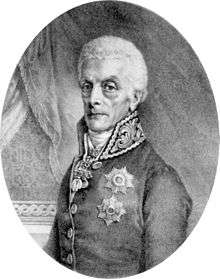Ferdinand von Trauttmansdorff
Ferdinand von Trauttmansdorff (1749–1827) was an Austrian diplomat and statesman. From 1787 to 1789 he was Minister plenipotentiary of the Austrian Netherlands, ruling on behalf of Emperor Joseph II.
Count Ferdinand von Trauttmansdorff | |
|---|---|
 Lithograph portrait by Friedrich Johann Gottlieb Lieder | |
| Minister plenipotentiary of the Austrian Netherlands | |
| In office 1787–1789 | |
| Monarch | Joseph II |
| Preceded by | Count Joseph Murray (acting) |
| Succeeded by | Philipp von Cobenzl |
| Personal details | |
| Born | 12 January 1749 Vienna |
| Died | 27 August 1827 (aged 78) Vienna |
| Nationality | Austrian |
| Spouse(s) | Marie Caroline von Colloredo |
| Alma mater | University of Vienna |
Life
Ferdinand was born in Vienna on 12 January 1749, a member of the noble family of Trauttsmandorff. He studied at the University of Vienna and served in the Reichskammergericht in Wetzlar. In 1772, he married Marie Caroline von Colloredo (1752–1832). At his brother's death in 1774, he became the head of the family, and count and prince of Trauttmansdorff.[1]
In 1780, he was appointed Austrian minister in Regensburg, and in 1785 imperial ambassador to the Archbishop-Elector of Mainz. In 1787, he was appointed the emperor's minister plenipotentiary in the Austrian Netherlands, effectively head of the government.
He arrived in Brussels in October 1787. His brief was to push through the innovations that Joseph II had determined on and that the previous minister plenipotentiary, Ludovico, Count di Belgiojoso, had been forced to dial back. In his zeal to execute imperial policy, Trauttmansdorff carried out a government coup on 18 June 1789, rescinding the ancient privileges of the county of Hainaut, decreeing the abolition of the Council of Brabant, and arbitrarily imprisoning many of the opponents of government policy. His dictatorial behaviour precipitated the Brabant Revolution. Count Richard d'Alton, General Commander of Imperial Forces in Austrian Netherlands was against such drastic reforms and advised against them. In November, he began to offer concessions and recognise ancient liberties, but too late to stem revolutionary rejection of Austrian authority.[2] On 14 December 1789, Trauttmansdorff fled Brussels for Luxembourg. His secret correspondence with Joseph II while minister plenipotentiary was published in 1902.[3]
He re-entered imperial service in 1793, being appointed to the Chancery for the Netherlands in Vienna. He accompanied the Emperor Francis II to Brussels for his reception as ruler during the short-lived Austrian restoration of 1793–1794.
Works
- Fragments pour servir à l'histoire des évenements qui se sont passés aux Pays-Bas depuis la fin de 1787 jusqu'en 1789 (Amsterdam, 1790).
References
- Joseph Lefèvre, "Trauttmansdorff, Ferdinand, graaf en prins van", Nationaal Biografisch Woordenboek, vol. 4 (Brussels, 1970), 837-842.
- Henri Pirenne, "Trauttmansdorff (Ferdinand, comte puis prince de)", Biographie Nationale de Belgique, vol. 25 (Brussels, 1932), 547-552.
- H. Schlitter, Geheime Correspondenz Jozefs II. mit seinem Minister Ferdinand Grafen Trauttmansdorff (Vienna, 1902).
| Preceded by Count Joseph Murray |
Authorized minister in the Austrian Netherlands 1787–1789 |
Succeeded by Philipp von Cobenzl |